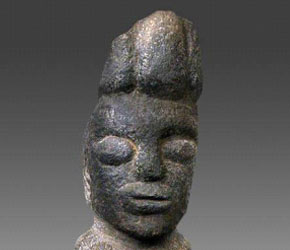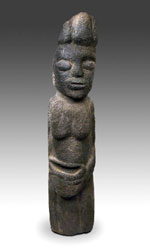Akwanshi Stone Monolith
 |
|
Considered by many to be the cradle of civilization, Africa is just beginning to yield some of its archeological secrets to our modern age. As recently as the early 1960s, 295 carved stone boulders or monoliths where discovered at 39 ritual sites in an area northwest of Ikom in the Cross River area, which spans the border between southeastern Nigeria and southwestern
The
 |
|
There is great debate about the actual age of the pieces. Some believe the monoliths date as far back as the early 16th century, while another source claims they are 4,000 years old. A piece at the
Present-day boundaries have little relevance when one considers the amount of time that has elapsed since the creation of these monoliths, whether it is 100, 500 or 4,000 years. Even now, the names of tribal groups, the countries they live in and their ethnographic as well as political boundaries have to be constantly updated.
While there are more questions than answers about these striking stone carvings, their visual power and spiritual resonance serve as a reminder that highly developed cultures preceded us in Africa. These so-called primitive peoples left evidence of their military, social and religious lives, their tribal struggles, collective spiritual aspirations, and most importantly, their ancestral past. In
{module_literature,i,138665}
Download this Article: A Chair To Hang Your Hat On.pdf
Download this Article: A Different Kind of Flame - Indian Oil Lamps.pdf
Download this Article: AdobePDF.pdf
Download this Article: A Flying Legacy.pdf
Download this Article: Akshobya Nepalese Buddha.pdf
Download this Article: Akshobya Nepalese Buddha.pdf
Download this Article: Akwanshi.pdf
Download this Article: A Long Lineage.pdf
Download this Article: Amitabha Dhyani Buddha.pdf
Download this Article: An Ancient Language - Christian Art in Ethiopia.pdf
Download this Article: A New Spin On An Old Debate.pdf
Download this Article: Antique Chinese Furniture.pdf
Download this Article: Appreciating Buddhist Art Part One.pdf
Download this Article: Appreciating Buddhist Art Part Three - Bodhisattvas.pdf
Download this Article: Appreciating Buddhist Art Part Two - Dhyani Buddhas.pdf
Download this Article: Appreciating Gongshi Part One – Early Standards and Scholars Rocks.pdf
Download this Article: Archaic Chinese Ceremonial Blades.pdf
Download this Article: Archaic Chinese Cong Form Vase.pdf
Download this Article: Archaic Chinese Hard Stone Artifacts.pdf
Download this Article: Archaic Chinese Hard Stone Bi.pdf